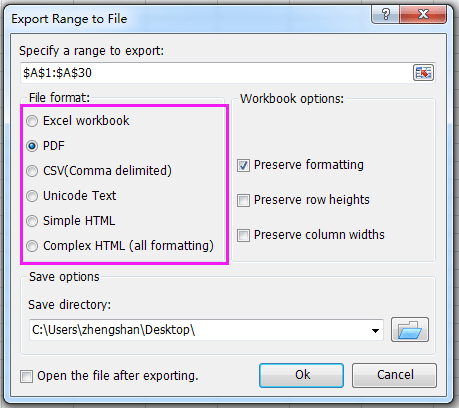Come convertire in batch più file CSV in file XLS(X) in Excel?
Convertire un file CSV in un file XLS o XLSX è molto facile utilizzando la funzione Salva con nome. Tuttavia, convertire più file CSV in file XLS o XLSX da una cartella salvandoli uno per uno manualmente può essere dispendioso in termini di tempo. Qui ti presento un codice macro per convertire rapidamente in batch tutti i file CSV in file XLS(x) da una cartella.
Convertire in batch file CSV in file XlS(X) con codice macro
Convertire in batch file CSV in file XlS(X) con codice macro
Per convertire più file CSV da una cartella in file XLS(X), puoi seguire i passaggi sottostanti:
1. Apri un nuovo workbook e premi Alt + F11 per aprire la finestra Microsoft Visual Basic for Applications e clicca su Inserisci > Modulo. Vedi screenshot:
Nota: Assicurati che tutti i file CSV che desideri convertire siano chiusi.
2. Quindi incolla il seguente codice macro nel modulo script e premi il tasto F5 per eseguire il codice.
VBA: Converti CSV in XLS
Sub CSVtoXLS()
'UpdatebyExtendoffice20170814
Dim xFd As FileDialog
Dim xSPath As String
Dim xCSVFile As String
Dim xWsheet As String
Application.DisplayAlerts = False
Application.StatusBar = True
xWsheet = ActiveWorkbook.Name
Set xFd = Application.FileDialog(msoFileDialogFolderPicker)
xFd.Title = "Select a folder:"
If xFd.Show = -1 Then
xSPath = xFd.SelectedItems(1)
Else
Exit Sub
End If
If Right(xSPath, 1) <> "\" Then xSPath = xSPath + "\"
xCSVFile = Dir(xSPath & "*.csv")
Do While xCSVFile <> ""
Application.StatusBar = "Converting: " & xCSVFile
Workbooks.Open Filename:=xSPath & xCSVFile
ActiveWorkbook.SaveAs Replace(xSPath & xCSVFile, ".csv", ".xls", vbTextCompare), xlNormal
ActiveWorkbook.Close
Windows(xWsheet).Activate
xCSVFile = Dir
Loop
Application.StatusBar = False
Application.DisplayAlerts = True
End Sub3. Nella finestra di dialogo che appare, seleziona la cartella specifica contenente i file CSV che vuoi convertire. Vedi screenshot:
4. Clicca OK, tutti i file CSV nella cartella selezionata sono stati convertiti in file XLS al suo interno.
Suggerimento: Se vuoi convertire i file CSV in file XLSX, usa il seguente codice VBA.
VBA: Converti file CSV in XLSX
Sub CSVtoXLS()
'UpdatebyExtendoffice20170814
Dim xFd As FileDialog
Dim xSPath As String
Dim xCSVFile As String
Dim xWsheet As String
Application.DisplayAlerts = False
Application.StatusBar = True
xWsheet = ActiveWorkbook.Name
Set xFd = Application.FileDialog(msoFileDialogFolderPicker)
xFd.Title = "Select a folder:"
If xFd.Show = -1 Then
xSPath = xFd.SelectedItems(1)
Else
Exit Sub
End If
If Right(xSPath, 1) <> "\" Then xSPath = xSPath + "\"
xCSVFile = Dir(xSPath & "*.csv")
Do While xCSVFile <> ""
Application.StatusBar = "Converting: " & xCSVFile
Workbooks.Open Filename:=xSPath & xCSVFile
ActiveWorkbook.SaveAs Replace(xSPath & xCSVFile, ".csv", ".xlsx", vbTextCompare), xlWorkbookDefault
ActiveWorkbook.Close
Windows(xWsheet).Activate
xCSVFile = Dir
Loop
Application.StatusBar = False
Application.DisplayAlerts = True
End SubConverti o esporta un intervallo in file separati XLS, Word, PDF e altri |
Di solito, Excel non offre un'opzione rapida per esportare o salvare un intervallo selezionato direttamente come file CSV, Excel o altri tipi di file. Per farlo, sarebbe necessario utilizzare una macro VBA oppure copiare manualmente l'intervallo in una nuova cartella di lavoro prima di salvarla. Kutools per Excel semplifica questo processo con la sua utilità Esporta intervallo in file, che ti permette di gestire queste operazioni in modo rapido e semplice con pochi clic. |
|
Kutools per Excel - Potenzia Excel con oltre 300 strumenti essenziali. Goditi funzionalità AI gratuite per sempre! Ottienilo ora |
Articoli correlati:
- Come convertire un file csv in un file xls o importare/aprire un file csv in Excel?
- Come convertire un documento Word in un foglio di lavoro Excel?
I migliori strumenti per la produttività in Office
Potenzia le tue competenze in Excel con Kutools per Excel e sperimenta un'efficienza mai vista prima. Kutools per Excel offre oltre300 funzionalità avanzate per aumentare la produttività e farti risparmiare tempo. Clicca qui per ottenere la funzione di cui hai più bisogno...
Office Tab porta le schede su Office e rende il tuo lavoro molto più semplice
- Abilita la modifica e lettura a schede in Word, Excel, PowerPoint, Publisher, Access, Visio e Project.
- Apri e crea più documenti in nuove schede della stessa finestra invece che in nuove finestre.
- Aumenta la produttività del50% e riduce centinaia di clic del mouse ogni giorno!
Tutti gli add-in Kutools. Un solo programma di installazione
La suite Kutools for Office include add-in per Excel, Word, Outlook & PowerPoint più Office Tab Pro, ideale per i team che lavorano su più app di Office.
- Suite tutto-in-uno — Add-in per Excel, Word, Outlook & PowerPoint + Office Tab Pro
- Un solo programma di installazione, una sola licenza — configurazione in pochi minuti (pronto per MSI)
- Funzionano meglio insieme — produttività ottimizzata su tutte le app Office
- Prova completa30 giorni — nessuna registrazione, nessuna carta di credito
- Massimo risparmio — costa meno rispetto all’acquisto singolo degli add-in
